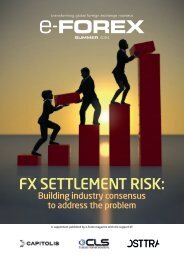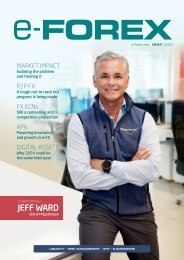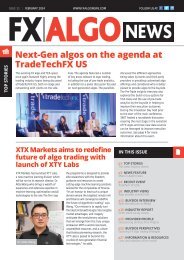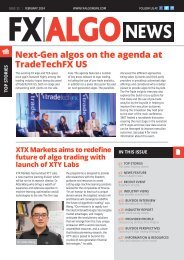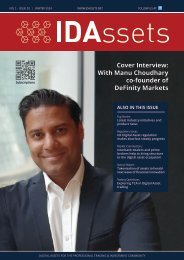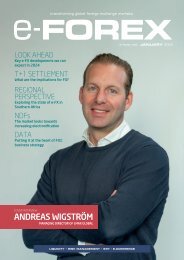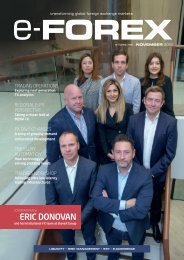Create successful ePaper yourself
Turn your PDF publications into a flip-book with our unique Google optimized e-Paper software.
FX Swaps<br />
The only constant is change<br />
e-<strong>Forex</strong> speaks with Stephan von Massenbach, Chief Revenue Officer at DIGITEC, about<br />
the numerous changes that are taking place in the FX Swaps market. Stephan talks about<br />
the increasing client demand for electronic Swaps prices, trader workflow automation,<br />
implementing advanced technology to deliver accuracy and speed, making technology<br />
available to regional banks using SaaS, and the growth of the interbank market.<br />
ASK A PROVIDER<br />
Additionally, the rise in interest rates<br />
and longer-term yields has amplified<br />
this move and contributed towards<br />
increasing volumes in FX Swaps, as<br />
far-side clients have sought to hedge<br />
FX exposures.<br />
As the FX Swaps market has grown,<br />
clients have increasingly demanded<br />
that their relationship banks provide<br />
liquidity across multiple currencies and<br />
tenors. When the market was smaller,<br />
banks used to price FX Swaps manually<br />
or use Excel, but the increased<br />
volume of FX Swaps has led to more<br />
electronic trading and an interest in<br />
more efficient and scalable technology<br />
solutions.<br />
What is the impact of automation?<br />
How is the FX Swaps market<br />
evolving?<br />
The latest BIS Triennial survey showed<br />
that FX Swaps accounted for $3.8<br />
trillion per day in April 2022. (See chart<br />
on facing page).<br />
Stephan von Massenbach<br />
Traditionally, repos and money markets<br />
were seen as important instruments<br />
for firms looking to roll, hedge, or<br />
fund their positions. Over the past few<br />
years, there has been a sustained move<br />
towards FX Swaps fulfilling this need as<br />
a source of global funding.<br />
The FX Swaps market is now at a point<br />
where the majority of client trades are<br />
electronic, and workflows automated<br />
(to increase efficiency and make more<br />
prices to clients). These greater levels of<br />
automation and electronic trading have<br />
led to increased market velocity, which<br />
translates into a greater need for speed<br />
and lower latency, as markets react<br />
more quickly to events.<br />
56 NOVEMBER 20<strong>23</strong> e-FOREX




